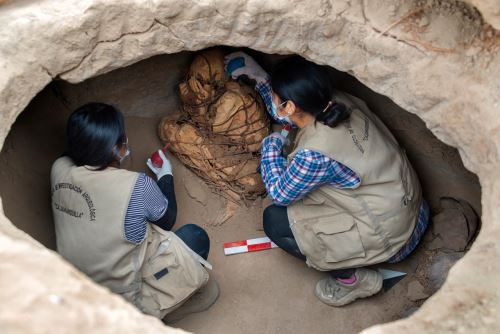A group of Peruvian archaeologists unearthed a pre-Inca mummy between 800 and 1,200 years old in perfect condition in the millennium Cajamarquilla archaeological centerlocated in the district of Lurigancho-Chosica, on the outskirts of the city of Lima.
Those responsible for the Cajamarquilla archaeological project, affiliated with the National University of San Marcos (UNMSM) They noted that the remains were found in a 2-meter-deep burial structure that was covered with a large mud rock.
Next to the mummy, a boleadora (stone weapon), a mate (plate), a copper needle, ceramic pieces, rope and pieces of skin and hair were also found; in addition, remains of textiles, corn and chili.
According to the team of archaeologists, the pre columbian mummy He was probably a teenager, about 12 or 13 years old, with an approximate height of 1 meter 30 centimeters. These remains were found in a underground tomb wrapped in a funeral bundle, located in the urban center of mud on the outskirts of Lima, capital of Peru.
The archaeologist Yomira Huamán, responsible for the Cajamarquilla Archaeological Projecttold AFP that the individual, whose sex is unknown for now, was probably an inhabitant of the Ichma culture that existed about 900 years ago before being annexed by the Inca Empire in the 15th century.
“The coarse sand in the area, with high salt components, would have generated a natural mummification process, which has allowed the arms, forearms and both legs to retain traces of skin, while the head, separated from the body, maintains locks of hair, and in the case of the jaw, part of the teeth can still be seen”, commented the leader of the archaeological project.
It should be noted that, in February 2022, the researchers at the archaeological site They found the remains of 20 mummies, including 8 children and 12 adults, who apparently were sacrificed between 800 and 1,200 years ago.

cajamarquilla It was an urban center where multiple functions were developed such as administrative, domestic and residential sectors. The place is considered a pre-Hispanic mud city, which could have housed between 10,000 and 20,000 people in an area of 167 hectares.
The site was built around the year 200 BC and was occupied until the year 1500. The city is located 24 km east of Lima and is one of the archaeological complexes largest in the Peruvian capital.
This extensive Cajamarquilla complex It has the ruins of four pyramids and other constructions, such as maze-shaped walls. The complex is the second largest adobe city in Peru after Chan Chan in the north of the Andean country.

About 1,700 objects prehispanic archaeological they were found while the works of underground hydrocarbon distribution networks were being carried out in the last 8 years, reported Cálidda, the company in charge of the public natural gas service in the cities of Lima and Callao.
Pre-Hispanic architecture, stone walls and mud walls have been found in these more than 400 huacas, the name of the tombs of the Inca indigenous people, the entity reported.
“We have found offerings of vessels and also many burials,” according to the archaeologist Cecilia Camargowho assures that as soon as a discovery is made, the company’s works stop in order to recover the vestiges of Inca daily life that provide important details about the history of the last 2,000 years in these cities.
These finds date from different historical moments, from a community of two thousand years ago that still has no name, but is referred to as the White on Red style to findings of the Lima culture prior to Ichma culture located approximately between the years 1100 to 1469.
As seen in the video, the findings can be found a few meters deep in the streets of any area of the city, a fact that is a reminder of the evolution of societies and the rich cultural legacy.
He head of excavation units 5 and 8 of said archaeological complex, Jorge Pérezhighlighted the fact that it is the first time that an individual has been discovered within a funerary matrix of unit 8, whose access was covered by a rammed earth (mud rock).
About him grave goods Found next to the body, the archaeologist told Agencia Andina that it includes a boleadora (stone weapon), a mate (plate), a copper needle, textile material (wrappers) and botanicals, such as corn and chili.
After remove the bodyexplained the specialist, the cabinet stage continues, where the analysis of the body, botanical, malacological (marine shells), lithic and metal material will be carried out.
This research phase It is very important because, as he indicated, it will be possible to identify the activities that the individual carried out, that is, what he did, what he could have died of and the diseases he suffered, among other aspects.

Work and studies in the area are part of the so-called Cajamarquilla Archaeological Project of the National University of San Marcos, whose head is Yomira Huamán.
At this stage of the project, which began in December last year and will end in December 2023, it is planned to work on 23 excavation units. To date, three units have been excavated and another four are in the process.

The members of the team responsible for the recent discovery in Cajamarquilla They are the San Marcos archaeologists Yomira Huamán, Jorge Pérez, Fabiola Kupa, Xavier Huamán and Alicia Flores. Likewise, archaeologists from the San Cristóbal de Huamanga National University (Ayacucho): Wilton Sedano and Ruth Escalante, as well as workers Johan Villantor and Dan López.
